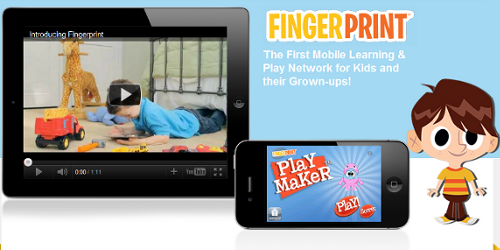By Tech Powered Dad | December 1, 2011

This week a new app company, Fingerprint Digital, has gone public with a series of educational apps targeted towards children between the ages of 3 and 8. The company was founded by Nancy MacIntyre, a former Leapfrog executive who saw the opportunity to create a platform for a network of edutainment apps within iOS. Fingerprint is aiming to make a splash with the new apps by giving away $1,000,000 worth of downloads of their apps (valued at $2.99 each).
I got a chance to try out a couple of Fingerprint apps for the iPad prior to their release in the App Store was impressed with what I saw. My reviews will be posted over the next couple of days. Fingerprint apps are characterized by a high level of customization and the ability to interact between parent and child. Earlier this week, MacIntyre answered a few questions for me about Fingerprint and the potential for learning on touch screen devices.
What led you to start Fingerprint, and what is your vision for the company?
Quite simply, I became obsessed with the possibilities around touch screens and kids. I saw right away that we could bring new types of gaming experiences to even the youngest gamers for both learning and play. My vision initially was pretty simple – to create a new kind of mobile based edutainment company with apps that parents trusted and kids loved. What I realized along the way was that it was possible to create experiences that were shared by parents and child – taking app play from a solo experience to a shared experience – that’s the foundation for Fingerprint.
Having been a part of Leapfrog prior to founding Fingerprint, what advantages or disadvantages have you noted a platform like the iPad has over standalone education devices like Leapfrog makes?
I’ll start by saying that I love the LeapPad. I think LeapFrog has created something special there! LeapFrog and Nintendo are dedicated devices designed to provide a great experience for the child – while iPad is a great experience for the whole family. The biggest advantage the iPad brings is accessability to lots of great inexpensive content. Instead of needing to buy game content at retail for $15-20 or download proprietary content for $3-5 from LeapFrog, the iPad offers literally thousands of app choices at less than $3 that are instantly available.
There have been a lot of schools this year purchasing classroom sets of iPads. What do you think the future is of apps as a classroom instructional tool versus as an enrichment activity in the home?
I look at iPads in the classroom the same way I look at computers – if we accept computers in the classroom as an instructional tool we should accept iPads. Since the iPad is portable and a “personal learning device” It will be interesting to see how learning content is created that promotes the home – school connection.
Trying out a couple of Fingerprint apps over the last week, I almost felt like it was its own ecosystem within iOS. You can jump from one Fingerprint app to another seamlessly, track a child’s progress, and parent and child can exchange messages of encouragement all within the apps. How do you feel this system might grow or evolve over time?
That’s an exciting question. And one that the team is having fun discussing! You’re going to see us expand features that facilitate sharing features between parent and child and ultimately between child to child. We think that there is a lot of room for collaborative experiences between kids and grown-ups and child to child. I can’t say more than that right now, but stay tuned.
Your apps offer a lot of customization for children. In some cases, they can even record their own sound effects for the games. How are you finding that children respond to being able to shape their learning environment in this way?
Kids seem to absolutely love the recording aspect. In our PlayMaker App, kids can record a Happy Sound when they get an answer correct or a Sad Sound when they are wrong. You can imagine the fun when a kid gets to hear their own crazy recording or to get a recording from a parent. We’re also seeing that customization is very shareable. Our testing showed that kids liked to show off their characters and backgrounds to parents even before they started playing. The bottom line for us is that we’re trying to create shareable moments that engage both parents and children.

